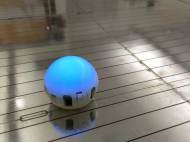Droplets – team of tiny swarming robots
 Many research groups around the world have been inspired by swarms and they have been striving to develop suitable platforms and different algorithms. A group of researchers from the University of Colorado Boulder has developed a basic robotic building block called droplet, and they hope they’ll be able to reproduce it in large quantities to develop systems with gradually increasing complexity.
Many research groups around the world have been inspired by swarms and they have been striving to develop suitable platforms and different algorithms. A group of researchers from the University of Colorado Boulder has developed a basic robotic building block called droplet, and they hope they’ll be able to reproduce it in large quantities to develop systems with gradually increasing complexity.
Assistant Professor Nikolaus Correll and his computer science research team, including research associate Dustin Reishus and professional research assistant Nick Farrow, recently the team created a swarm of 20 droplets. Each robot has the size of a pingpong ball and they move by using fixed legs and vibration motors. The robots can sense RGB color and IR, and transfer data among each other via analog or digital IR signals.
The embedded software layer is what we use to write and compile on-board code for the droplets. Each robot is equipped with an Atmel XMega 128-A3 microprocessor capable of running embedded C-code. The software simulation environment consists of a simulator for the entire platform that allows virtual tests of the robot before the code is compiled and deployed onto the hardware. This feature is useful for research because it allows the simulation on thousands of robots without the need to actually build them.
“Every living organism is made from a swarm of collaborating cells”, said Correll. “Perhaps some day, our swarms will colonize space where they will assemble habitats and lush gardens for future space explorers.”
Similar to the fictional “nanomorphs” depicted in the Terminator movies, large swarms of intelligent robotic devices could be used for various tasks. Swarms of robots could be used to contain an oil spill or to self-assemble into a piece of hardware after being launched separately into space.
To accelerate the pace of innovation, Correll has created a lab where students can explore and develop new applications of robotics with basic, inexpensive tools. He hopes to create a design methodology for aggregating the droplets into more complex behaviors such as assembling parts of a large space telescope or an aircraft.
Correll also plans to use the droplets to demonstrate self-assembly and swarm-intelligent behaviors such as pattern recognition, sensor-based motion and adaptive shape change. These behaviors could then be transferred to large swarms for water- or air-based tasks.









I wrote an article a while back about other steerable vibrobots, including the Harvard Kilobots and how to build your own (courtesy Naghi Sotoudeh). Since the Droplets use the same actuation technique, you might find the article interesting:
http://www.hizook.com/blog/2011/09/08/infrared-remote-controlled-rc-steerable-vibrobot-created-naghi-sotoudeh
We just launched a crowdfunding campaign to help us make a “liquid that thinks” from a 1000 Droplets.
http://www.colorado.edu/crowdfunding/?cfpage=project&project_id=10341
Please support us by spreading the word!